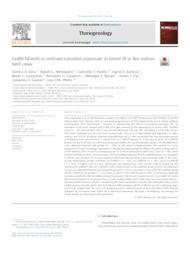GnRH34 with or without estradiol cypionate in timed AI in Bos indicus beef cows.
GnRH34 with or without estradiol cypionate in timed AI in Bos indicus beef cows.
Author(s): SILVA, S. A.; MONDADORI, R. G.; NOLETO, G. S.; BARBOSA, I. P.; GONÇALVES, R. L.; GASPERIN, B. G.; ROVANI, M. T.; PAZ, E. F.; GOMES, L. S.; PFEIFER, L. F. M.
Summary: Two experiments were performed to evaluate the effects of GnRH treatment on the fertility of suckled Nelore beef cows treated with an estradiol/progesterone (E2/P4)-based protocol for timed artificial insemination (TAI). Experiment 1 focused on determining the effects of estradiol cypionate (EC) on ovulation in TAI cows treated with GnRH 34 h after removal of the intravaginal P4 device (IPD). Suckled cows (n ¼ 26) were treated with 2 mg estradiol benzoate (EB) and IPD containing 1 g P4. After 8 days, IPDs were removed, and all cows were treated with 150 mg of d-cloprostenol (prostaglandin F2 alpha analog) and 300 IU of equine chorionic gonadotropin (eCG), then separated into two treatment groups consisting of cows who received 1) saline 0.9% i.m. (GnRH34 group) or 2) 0.6 mg i.m. of EC (EC-GnRH34 group). On day 9 (05:00 p.m.), all cows were given GnRH (10.5 mg of buserelin acetate) i.m. No differences were observed between the groups (P > 0.05) in the time of ovulation after IPD removal or in the proportion of cows ovulating. Experiment 2 focused on determining the effects of GnRH34 along with or in the absence of EC on day 8 on pregnancy per AI (P/AI) in postpartum beef cows. Cows (n ¼ 981) were treated similarly to those in Experiment 1, but an additional group, the EC-GnRH48 group, was included, in which cows received EC on day 8 whereas those that did not show estrus received GnRH at TAI. Thus, in this experiment, groups consisted of GnRH34 (n ¼ 322), EC-GnRH34 (n ¼ 335), and EC-GnRH48 (n ¼ 324). A higher rate of estrus expression was observed in cows treated with EC following IPD removal (EC-GnRH34: 69%, EC-GnRH48: 64.8%) than in cows in the GnRH34 group (45.6%). No difference in P/AI was observed between the treatment groups (P ¼ 0.45), but P/AI in cows in the EC-GnRH34 group (64.2%) tended to be greater (P ¼ 0.1) than in cows in the GnRH34 group (58%). In summary, although ovulation synchrony did not differ among the groups, P/AI in cows treated with EC and GnRH 34 h after IPD removal tended to be greater than in cows treated solely with GnRH; this was most likely due to a shorter proestrus/estrus period, considering the lower proportion of cows that displayed estrus in the GnRH34 group. Finally, given that P/AI did not differ between the EC-GnRH34 and EC-GnRH48 groups, our results suggest that, for cows not displaying estrus, administration of EC at the time of IPD removal followed by treatment with GnRH 48 h afterward represents the most cost-efficient TAI strategy for South American Zebu-based beef operations.
Publication year: 2023
Types of publication: Journal article
Unit: Embrapa Rondônia
Keywords: Amazônia Ocidental, Animal fertility, Animal reproduction, Beef cows, Bos Indicus, Campo Experimental, Demonstration farms, Embrapa Rondôna, Estradiol, Fertilidade Animal, Gado Nelore, Hormones, Hormônio, Nellore, Ovulation, Ovulação, Pregnancy, Prenhez, Reprodução Animal, Vaca de Corte, Western Amazon
Observation
Some of Embrapa's publications are published as ePub files. To read them, use or download one of the following free software options to your computer or mobile device. Android: Google Play Books; IOS: iBooks; Windows and Linux: Calibre.
Access other publications
Access the Agricultural Research Database (BDPA) to consult Embrapa's full library collection and records.
Visit Embrapa Bookstore to purchase books and other publications sold by Embrapa.

